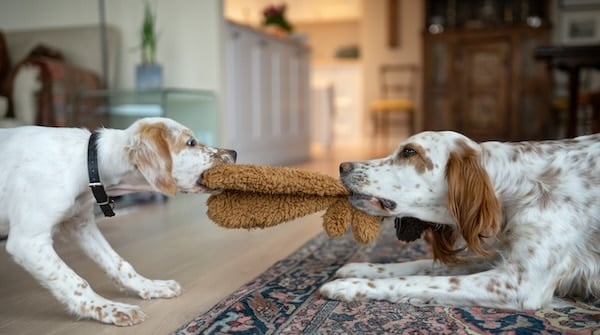When you have a new puppy, there’s a lot to learn—for both puppy and puppy parents. Most dog guardians include cues like sit and stay in their training plan. But knowing how to socialise a puppy properly is a critical element of puppy education that’s often overlooked.
To help you understand more about puppy socialisation, why it’s important, and how to implement it, we’ve enlisted the help of a certified professional dog trainer and behaviour expert.
What Is Puppy Socialisation?
Many people think puppy socialisation is just teaching your puppy how to socialise with other dogs and get along with other people. That’s definitely part of it, but puppy socialisation is much more extensive—and so are the consequences of doing it improperly.
“Dog socialisation is when a pet parent purposefully exposes a dog to unfamiliar people, dogs, and settings to get them used to the world around them,” says Alexandra Bassett, lead dog trainer and behavioural consultant of Dog Savvy. This means socialisation is just as much about how your puppy interacts with the world as with other animals and people.
It’s natural to want to protect your puppy from things that may scare them by keeping them safe at home. But an unsocialised puppy can quickly grow into a reactive dog, triggered by everyday events and experiences. This, Bassett says, can make taking your dog anywhere a challenge—and it might even be hard to live with them. Imagine a dog who is triggered by every doorbell, every person on the street, and every dog they see.
The crucial puppy socialisation window
Socialisation can happen at any age, but it’s much more difficult when a dog is older. With young dogs, pet parents can take advantage of the ‘socialisation window’.
“For puppies, the ‘socialisation window’ is the time period between the ages of three to 16 weeks, when they will most readily accept ‘novel stimuli’ (meaning anything new or unfamiliar),” explains Bassett.
Typically, this brief window starts when a puppy is still with their mother, and lasts a month or two past the minimum adoption age. That means that all of a dog’s early caretakers (breeders, rescuers, fosters, and adopters) should play a role in their socialisation.
“A reputable breeder should provide a puppy with plenty of positive, early socialisation experiences to help him become more resilient to stress and adapt more quickly to his new home once he gets adopted,” Bassett explains. “This can be done by separating the puppy from his litter and gently handling him or exposing him to new environments and people for brief periods once he has reached three weeks of age, up until the day of his adoption.”
Once the puppy is adopted, it’s up to the new pet parents to continue socialisation.
What Should Puppy Socialisation Look Like?
One part of puppy socialisation is conditioning pups to consider a wide variety of people, animals, and experiences as normal and non-threatening. The other part is building resilience and preparing them to handle unexpected events with relative ease. If you’ve done the first part, working on the second will usually be easier. The more things a dog sees as ‘normal’, the less likely they will be upset by the unfamiliar.
During the socialisation window, you’ll want to expose your puppy to a wide range of people, animals, surfaces, sounds, and environments. Focus especially on the things your puppy is likely to encounter throughout their life. For some dogs, this could mean getting used to car rides, while for others, it might look like riding calmly on public transport.
Puppy socialisation should also include handling your puppy in a way that gets them comfortable with grooming, vet visits, and things like taking pills or trimming nails.

Arvydas Lakacauskas via iStock
Puppy socialisation checklist
To help you out, we’ve put together a puppy socialisation checklist. Some items on the list may seem bizarre to a human, but it’s important to remember that dogs don’t have the same context that we do. Even a rubbish bin with a lid could be triggering to an unsocialised pup.
And while this list is extensive, it’s not exhaustive. You’ll also want to add unique situations likely to come up in your and your puppy’s life together.
Animals:
- cats
- cows and other livestock like sheep, pigs, and chickens
- horses
- other dogs of all sizes and breeds, from tiny to giant
- other puppies
- pet birds
- small pets like rodents, lizards, and snakes
Everyday objects:
- balloons, including latex and mylar
- bins, both with and without lids
- computers
- cooking pots, pans, and appliances like mixers
- plastic bags in the wind
- rubbish bags
- sports balls and equipment
- street and pavement signs
- training clickers
- TV and video game noises
- umbrellas
Handling and touching:
- brushing or combing
- holding in your lap and in your arms
- touching and cleaning inside and outside of the ears
- handling the inside and outside of the mouth
- brushing teeth
- handling nose and eyes
- touching and wiping paws
- clipping nails
- picking them up
- putting on and holding them by a collar or harness
- tail
- wiping their body and face with a towel
- bathing
People:
- with a cane, crutches, or wheelchair
- of all ages, from toddlers to the elderly
- of different ethnicities
- running or riding on bikes and skateboards
- wearing hats, sunglasses, and backpacks
- with beards and other facial hair
- of both sexes
Places:
- bodies of water like lakes, ponds, streams, and rivers
- busy pavements and streets
- daycare
- dog-friendly events like fairs, outdoor markets, and concerts
- elevators
- petrol stations
- hiking trails
- other people’s homes
- parking lots
- parks with other dogs, people, and children
- pet stores and groomers
- recreational trails with runners, walkers, and cyclists
- restaurant patios
- vet surgeries
Sounds:
- car and train horns
- barking
- construction equipment and machinery
- fireworks
- household appliances like the dishwasher and washer and dryer
- knocking and ringing the doorbell
- loud music
- other animals
- people talking
- car doors slamming
- sirens
- thunder
- vacuum cleaner
Surfaces:
- artificial grass
- carpeting
- concrete
- dirt and sand
- gravel
- metal surfaces
- rocky and uneven terrain
- smooth floors like tile, linoleum, and hardwoods
- snow and ice
- stairs
- wet grass and mud
Transport:
- aeroplanes
- baby strollers
- bicycles, skateboards, and roller skates
- boats
- cars
- large vehicles like busses and bin trucks
- loud vehicles like motorcycles
- motorised scooters
- shopping carts
- snowploughs

ROMAOSLO via iStock
How To Socialise a Puppy Before Vaccinations
At one time, experts believed puppies shouldn’t start socialising until they were fully vaccinated. Waiting for your puppy’s final round of vaccinations, however, usually means that you miss some of the critical socialisation window. Many experts now agree that socialisation should occur even before your pup has all of their shots—just with a fair amount of caution.
Most pet illnesses and diseases are transmitted through animal waste and stagnant water. To socialise your puppy without exposing them to harmful germs, Bassett recommends investing in a comfortable carrier, like a backpack, tote, or stroller. These safety measures let you transport your pup outdoors without having them touch the ground. Indoors, puppies can walk on their own, meet humans, and even visit with older dogs who are fully vaccinated (and who haven’t recently been to a dog park).
When can a puppy be around other dogs?
According to the American Veterinary Society of Animal Behavior (AVSAB), puppies can join socialisation classes when they’re around seven to eight weeks old. Of course, safety is always a concern for young dogs, especially in big rambunctious groups. Make sure that you seek out a reputable trainer or class provider, and that all dogs are up-to-date on their vaccinations. All pups should have one set of vaccines and their first deworming at least seven days before class starts.
Avoid ‘Flooding’ Your New Puppy
As a puppy parent, your role in socialisation is to make as many of your puppy’s early experiences as positive as possible.
One of the biggest mistakes new puppy parents make is overexposing their puppy (often called ‘flooding’). This puts the pup at risk of becoming overwhelmed and stressed, building a negative response to a situation.
“Puppy socialisation is NOT taking a puppy anywhere and everywhere before he’s ready,” says Bassett. “It should be done with care by making an effort to ensure the pup is having a positive experience every time he is exposed to something new. This means sometimes it’s better to leave a puppy at home rather than take him somewhere where he might have a bad experience.”
Keep experiences short
Bassett adds that brief exposures are typically the best. “Long exposures to unknown things where a puppy ends up feeling uncomfortable or scared or has a bad experience may do the opposite and can make a puppy afraid or aggressive,” she says.
She suggests a few ways to start your puppy socialisation training in safe, comfortable environments:
- Take your puppy to places you frequent, such as a park, a friend’s home, or your local coffee shop
- Take your pup on a ‘puppy picnic’ by putting down a blanket at a local park (to protect them from the ground) and letting them observe everything around them while on a lead
- Host a ‘puppy party’, inviting friends and family to your home to meet your new puppy
As your puppy becomes comfortable and confident in these situations, you can begin taking them to more places, letting them explore more of the world around them.
Learn to read your dog’s body language
Understanding when your dog is happy or uncomfortable based on his body language is critical to ensuring your puppy is getting the most out of your socialisation efforts. Every experience, good and bad, lays the foundation for how your dog will react to future experiences. If your puppy is uncomfortable, it’s best to remove them from the situation.
Typical signs of stress and discomfort in a puppy include:
- scratching
- lick lipping
- tucked tail
- pinned-back ears
- shaking or shivering
- stressed panting
- whale eye
- hiding or trying to escape
If you know the body language of a happy dog, you’ll also know when your puppy is having a good time. This includes:
- a relaxed stance
- a wiggly body
- play bows
- panting with a ‘smile’
- positive engagement with other dogs and humans
- taking treats gently
Don’t stop socialising after the window closes
The socialisation window is the best time to expose your puppy to new things, but it’s not the only time. Socialisation should continue throughout your puppy’s first year, especially if you adopted your new pup after the socialisation window closed. Sometimes, additional socialisation is needed in adulthood as well. The good news is that the more positive experiences your puppy has with the unknown in their early months, the better equipped they’ll be to handle new experiences as they grow.

